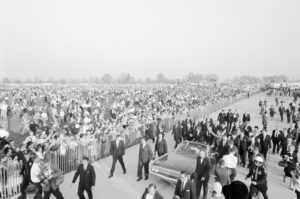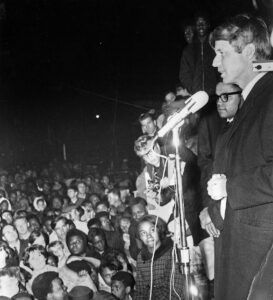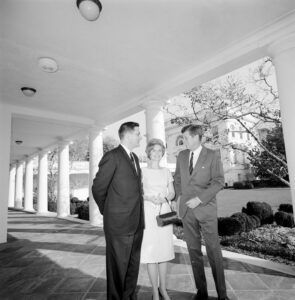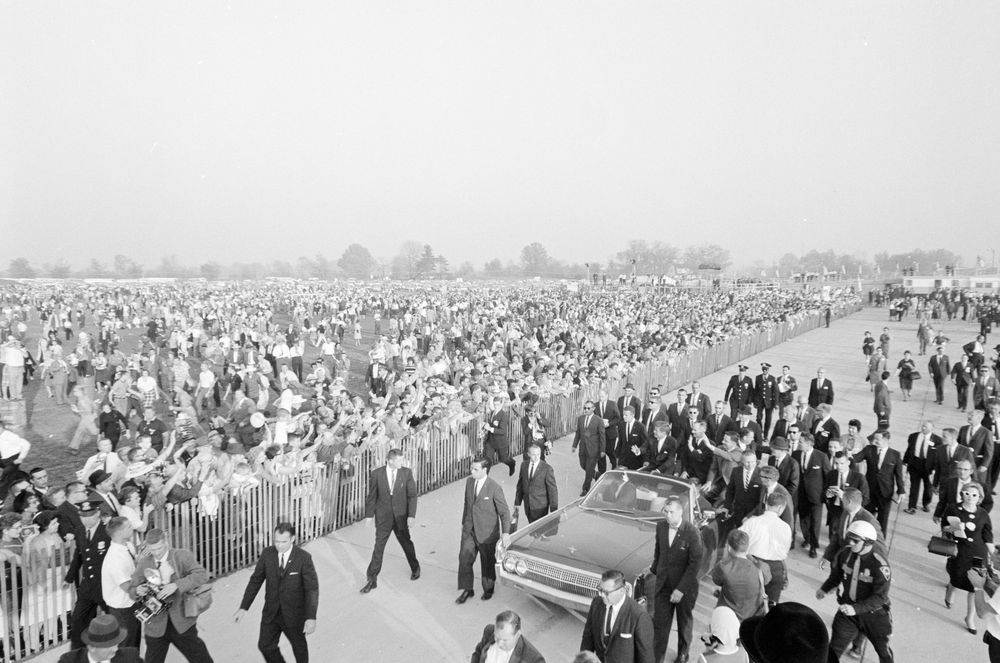Sixty Years Later: John F. Kennedy in Indiana
Writer / Jeff Kenney
Photography Provided
Surely most every local reader of an age to remember will recall exactly where they were when they heard that President John F. Kennedy had been assassinated. It may be hard to believe, but that tragic day – remembered perhaps alongside national 20th-century tragedies such as Pearl Harbor and the 9/11 attacks – took place 60 years ago this month, on November 22, 1963. 
And while Kennedy himself was not a Midwesterner, famously hailing instead from the east coast, this month seems an appropriate one to recollect a few of his several visits and connections to the Hoosier state.
One of the earliest, at least in relation to his presidency, took place on March 21, 1960, when then-Senator Kennedy flew to Indianapolis to officially file his entry in the May 3 Indiana presidential preference primary. Before doing so, he met for coffee with some 200 women at the Continental Hotel in that city.
Kennedy carried all seven state primaries he entered (Indiana was the seventh) on his way to the presidential nomination, defeating then-Vice President Richard M. Nixon by less than 115,000 popular votes and becoming the first president born in the 1900s, at age 43.
Senator Kennedy and his wife, Jackie, had already paid a visit to the area by the time he filed in March. The couple spent time on February 5, 1960, in northwest Indiana, including a tour of U.S. Steel in Gary.
Kennedy said the following during a press conference at the Hotel Gary that day: “If voters of Indiana do not love a candidate in May, neither they nor the nation is likely to love him in November.”
In April 1960, Kennedy visited several Indiana cities, including various stops on April 7 such as Madison County via the Anderson Municipal Airport. He visited the county courthouse, Eagles Lodge, the Pierce Governor plant, and rural and municipal locations in Alexandria. In all, more than 8,000 area residents saw the then-senator in that area.
The same day, Kennedy visited Lafayette, a city with which he was already familiar by way of a visit the previous year to Purdue University. Attending the Purdue-Notre Dame football game during the ’59 visit, Kennedy told an inquiring reporter that he felt that as a guest of the president of Purdue, he should be rooting for that university’s team, but “as an honorary doctor from Notre Dame, I should be for them. But as a graduate of Harvard, I’m a poor judge of big-time college football!”
One memorable campaign stop took place in Richmond, Indiana, where the most notable aspect of what Kennedy said was that he didn’t say anything!
After landing at Richmond Municipal Airport on April 29, 1960, Kennedy visited the city’s downtown as well as its well-known Earlham College. Unfortunately for him, the future president was struck with an attack of laryngitis and, arriving at Holy Family Catholic Church, was introduced by the staff member who delivered Kennedy’s prepared remarks as “the first presidential candidate in history who is speechless.”
The senator would return to Indiana’s state capitol on October 5 of that same year as part of a presidential campaign that included a stop at Anderson, where a bank had been robbed in nearby Edgewood the same morning. During his speech there, Kennedy jokingly predicted the headline: “Democrats arrive, bank robbed.”
JFK returned to the state capitol on October 13, 1962, for a rally at the Weir Cook Airport in Indianapolis in support of Indiana democratic candidates, and was joined by Governor Matthew Welsh and future U.S. Senator Birch Bayh Jr.
One lakes-area connection for Bayh relates to his son, future Indiana governor Evan Bayh, who attended Woodcraft Camp at Culver Military Academy in the mid-1960s.
 John F. Kennedy himself had a few connections to that school. Members of its Black Horse Troop rode in his inaugural parade in January 1961, and on March 25, 1963, Culver Military Academy cadet Philip Tovrea III joined Kennedy in dedicating Chicago’s O’Hare International Airport. Tovrea assisted in laying a wreath on a monument dedicated to Tovrea’s uncle, Lieutenant Commander Edward “Butch” O’Hare, alongside another nephew, Edward Palmer. O’Hare was the U.S. Navy’s first flying ace and a Medal of Honor recipient for his service in World War II.
John F. Kennedy himself had a few connections to that school. Members of its Black Horse Troop rode in his inaugural parade in January 1961, and on March 25, 1963, Culver Military Academy cadet Philip Tovrea III joined Kennedy in dedicating Chicago’s O’Hare International Airport. Tovrea assisted in laying a wreath on a monument dedicated to Tovrea’s uncle, Lieutenant Commander Edward “Butch” O’Hare, alongside another nephew, Edward Palmer. O’Hare was the U.S. Navy’s first flying ace and a Medal of Honor recipient for his service in World War II.
Among other dignitaries attending the event were Chicago Mayor Richard Daley and Illinois Governor Otto Kerner.
Of course, within nine months of the Chicago event, Kennedy, who had served just two years and 10 months as chief executive, was shot to death in Dallas.
Across Indiana, schools were closed for several days, as were municipal and state offices and some businesses. Only churches seemed fully operational that day in the wake of the tragedy, as prayerful mourners filled pews.
Memorial High Mass was held at St. Michael Catholic Church in Plymouth, as reported in the Pilot News newspaper of November 23. The same edition of the paper featured a photo of 15-year-old Carl L. Jones of Oak Hill Avenue in Plymouth, who had recently found a newspaper from April 16, 1865, in his home announcing the assassination of President Lincoln.
In the wake of Kennedy’s death, Indiana Governor Matthew E. Welsh said that his “first reaction is one of shock and dismay followed by one of concern for the family of President Kennedy. I am confident the people of the United States will rally to the support of President Johnson.”
The Reverend Theodore M. Hesburgh, well-known president of the University of Notre Dame, responded: “On behalf of the students, faculty members and the entire Notre Dame family, I wish to express to Mrs. Kennedy, to the children, and to the entire Kennedy family, our most profound sympathy on the sudden and tragic death of the president.”
“There is nothing I can say that would convey my feelings of loss and tragedy both to the president’s family and to the nation,” said U.S. Senator Birch Bayh Jr.
Among notable Hoosier-area memorials to the late president was the six-lane bridge across the Ohio River connecting Louisville, Kentucky, and Jeffersonville, Indiana, christened the John F. Kennedy Memorial Bridge. Construction had started in the spring of 1961 and work completed in late 1963 on the as-yet unnamed bridge. When Monsignor John N. Dudine suggested that the Kentucky legislature name the new bridge for President Kennedy, Kentucky Governor Bert T. Combs announced widespread agreement and the name changed.
Any consideration of President Kennedy and Indiana would be remiss not to mention one of the most famous speeches in U.S. history, delivered by the late president’s brother, Senator Robert F. Kennedy.
The younger Kennedy, running for the presidential nomination of the democratic party, was scheduled to deliver a speech at the Broadway Christian Center at 17th and Broadway streets, a majority-black neighborhood in Indianapolis, on April 4, 1968.
That fateful night saw rioting across the country in the wake of news of the assassination of the Reverend Dr. Martin Luther King Jr. earlier that day.
Kennedy was preparing to address the audience when news of the assassination hit, and he instead delivered impromptu remarks, credited by many with helping to quell the widespread violence that struck many U.S. cities, in the Hoosier capitol that night.
Kennedy began: “I have bad news for you, for all of our fellow citizens, and people who love peace all over the world, and that is that Martin Luther King was shot and killed tonight. Martin Luther King dedicated his life to love and to justice for his fellow human beings, and he died because of that effort.”
Kennedy recalled to the horrified crowd his own brother’s assassination, adding, “but we have to make an effort in the United States, we have to make an effort to understand, to go beyond these rather difficult times.”
Just two months later, Robert Kennedy himself would fall to an assassin’s bullet on June 6, 1968, though portions of his Indianapolis speech remain not only historically significant today, but perhaps prophetic and inspiring as well:
“What we need in the United States is not division; what we need in the United States is not hatred; what we need in the United States is not violence or lawlessness, but love and wisdom, and compassion toward one another, and a feeling of justice toward those who still suffer within our country, whether they be white or they be black.”
Jeff Kenney is museum and archives manager for Culver Academies in Culver, Indiana.










